Hymenoptera
Are you confused about the many types of bees that visit your lawn and garden, or maybe even concerned that some might be nesting in your home?
Sure, they all buzz around and collect pollen.
But many species look alike and are easy to get mixed up.
Some, like the carpenters, can become pests, drilling holes in wooden building materials to make nests. But they’re often confused with bumblebees, who don’t nest in wood or become problematic – unless they’re protecting their nest.
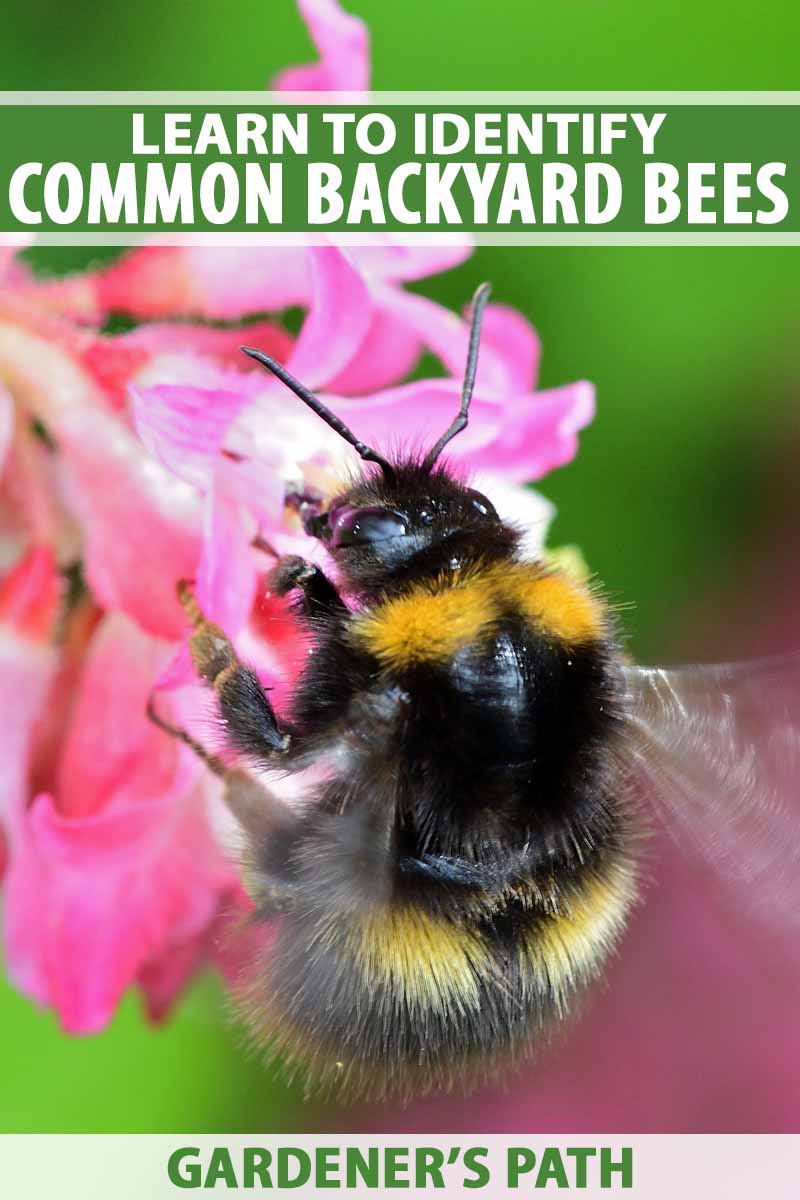
We link to vendors to help you find relevant products. If you buy from one of our links, we may earn a commission.
Others misidentify the wood-burrowing types with ground-tunneling ones, but these pose no threat to hearth and home either.
Some are solitary nesters while others are social. Some may sting, but many more are stingless and docile.
All act as significant pollinators for our crops, flowers, and trees.
And some of our native species now even face the risk of extinction.
So, before acting to rid your premises of bees, take a few moments to learn how to tell the most common species apart.
Most are harmless to humans and their homes, and it’s far more beneficial to your local and global ecosystems to leave them in peace – they have important work to do!
Here’s what we’re looking at:
Understanding Common Ground and Wood Nesting Bees
Native North American Bees
With over 4,000 species, native North American bees can be found anywhere that flowers bloom.
Unlike honeybees, which were imported by European settlers in the 1620s, most native species are socially solitary, nest in underground chambers, and produce no honey. But, there are always exceptions!
A key player in most ecosystems, they have a vital role in pollinating all blossoming plants, from food crops to wildflowers. And they’re particularly adapted for the reproduction of native plants, such as blueberries, cranberries, squash, and tomatoes.
Flying from flower to flower, they collect loose pollen on their body fur, cover their legs with it (creating what are referred to as “pollen pants”), or groom it into pollen baskets on their legs or tummies.
A naturally abundant source of protein, the collected pollen is used as a food source for the larvae that are growing in brood chambers.
The nectar the adults sip provides a high-octane fuel, and mothers will often collect enough to mix in with their stash of pollen to form “loaves” to lay their eggs on.
Most species are short lived, lasting only one season – just long enough to mate, nest, and lay eggs.
Commonly Confused Backyard Species
Bumblebees (Bombus)
Bumblebees belong to the Apidae family in the genus Bombus, and North America is home to approximately 50 species – most folks will be familiar with at least some of them.
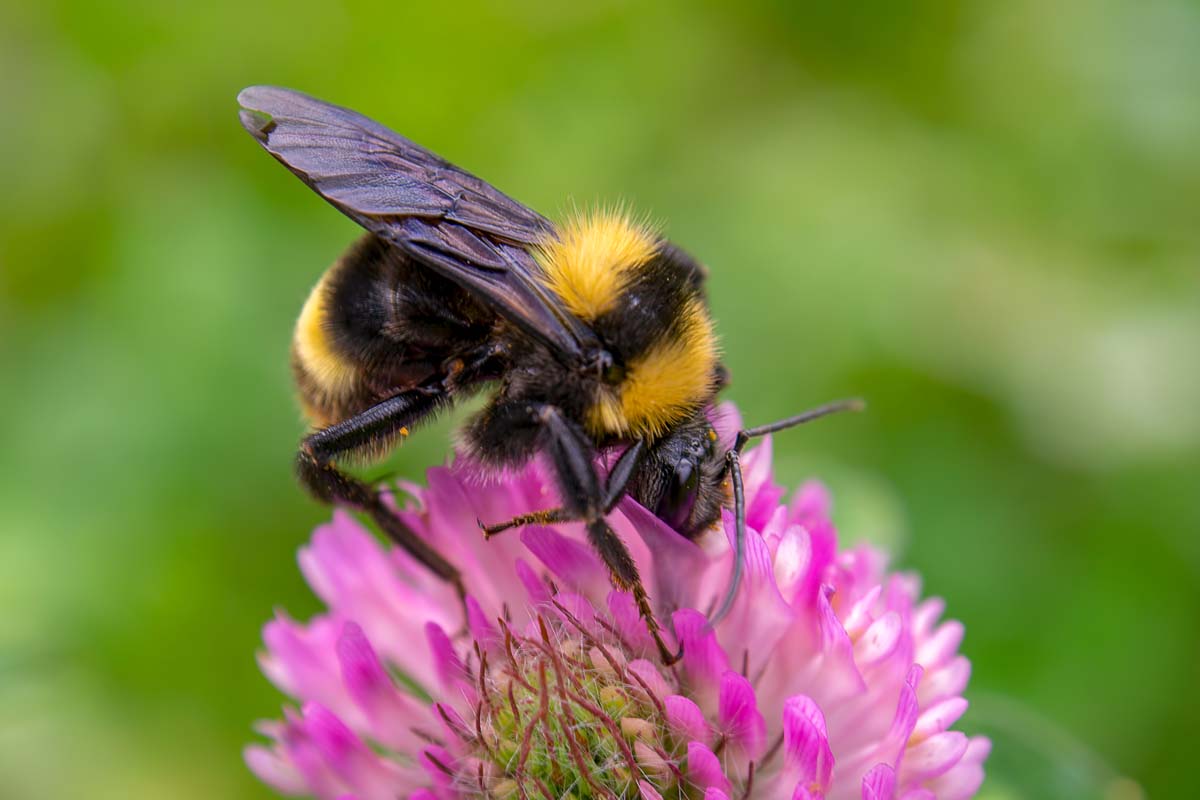
Ranging in size from 3/4 to 1 1/2 inches, they’re covered with short, spiky hair, are mostly black in coloring, and typically have stripes of orange, white, or yellow.
Highly social, they form colonies with a single queen and several workers – sterile females and male drones.
Male drones are stingless but queens and female workers can sting, although they’re usually non-aggressive. Females will sting when provoked to defend their nest, and queens usually only sting other queens.
Ground nesters, Bombus species often nest in an existing ground cavity such as an abandoned rodent burrow. Others simply make a nest on top of the ground and loosely cover it with thatch and vegetative debris.
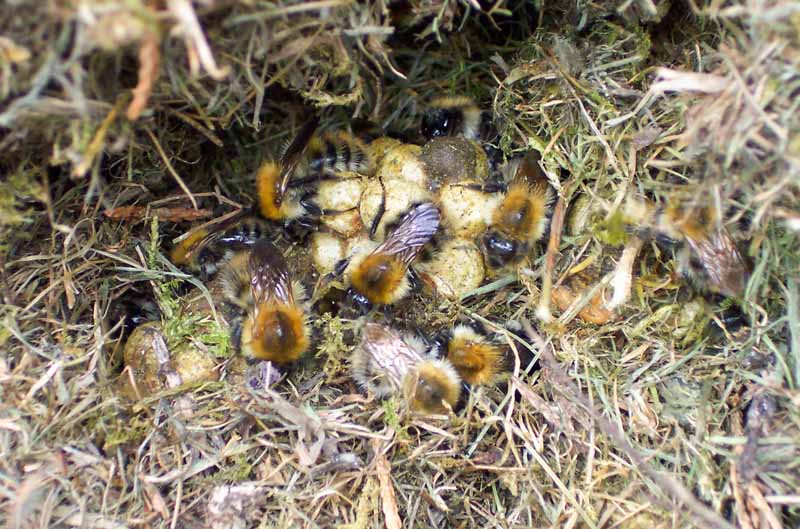
Once a site has been chosen, the queen constructs a few wax pots that she tops up with honey, to sip from while she tends her eggs. She also constructs a larger pot that gets stocked with a mixture of pollen and nectar. She lays her first brood of about six eggs on top of this mix – these will grow to be the sterile female workers.
Once the first batch has grown, she spends the remainder of her time laying more eggs while the workers tend to housekeeping chores and collect pollen.
Workers are usually smaller than the queen. This is why you rarely see the really big buzz-bombs after spring – they’re at home, laying eggs.
Females born after the first brood are not sterile and mate soon after emerging from the nest, adding more workers and drones. The colony grows quickly over the summer, with as many as two hundred workers, although a number closer to one hundred is the norm.
All the female workers, male drones, and the old queen die by summer’s end; the only survivors are the new generation of queens. Before winter, the new queens mate before finding a safe, sheltered spot to sleep away the cold weather.
However, our native bumblebees are under siege. According to the Xerces Society, more than one-quarter of all species face a significant risk level of extinction. Nests should be left undisturbed whenever possible.
Carpenters (Xylocopa)
Carpenters belong to the genus Xylocopa with seven species found in Canada and the US.

They measure approximately 1/2 to 1 inch in length with mostly black wings and bodies, plus stripes of yellow or orange. Some males have a white facial patch. There are also species with iridescent wings, and brightly colored body hair of blue or green.
Because of their similarity in size and coloring to large bumblebees, the two species are often confused.
The easiest way to visually distinguish between them is by looking at their abdomens. Bumblebees have abdomens covered with dense, short hair while carpenter abdomens are bare and may have a metallic sheen to them.
Carpenters also have wider heads compared to bumblebees.
Known for their docile nature, males are stingless, but like to hover near intruders. Females will sting, but only when roughly handled or aggressively provoked.
A solitary species, a single female does all the work of nest construction, plus collecting pollen and nectar for her eggs.
Their preferred nesting site is old, bare wood. The female rasps an entrance hole, then constructs a series of connecting chambers, or galleries, where she will lay a single egg atop a loaf of nectar and pollen.
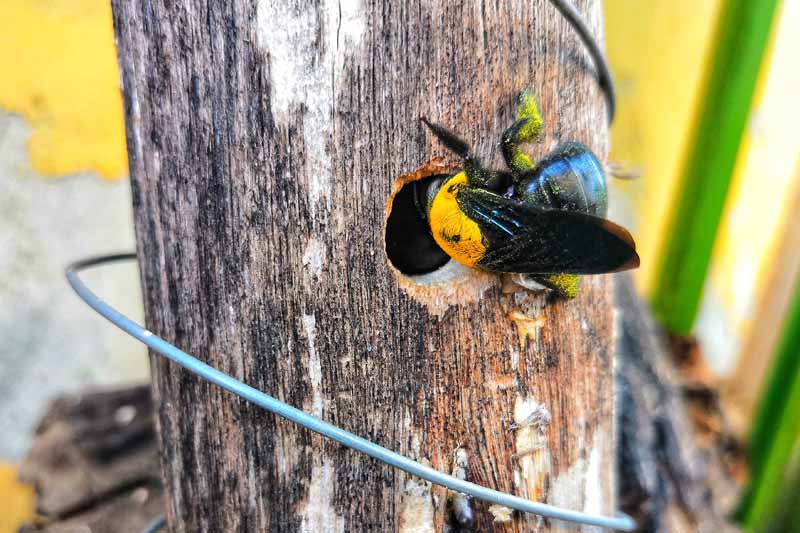
As each egg is laid, she encloses it with a partition of chewed wood pulp, and then creates another pollen loaf for the next egg. These will take about seven weeks to hatch.
At summer’s end, the new adults will provision a suitable nest with pollen and sleep through winter until spring, when the cycle begins again.
Borer, Ground, and Miners (Agapostemon, Andrena, Colletes, Halictus, Lasioglossum)
In North America, several families of ground nesting bees are found in the order Hymenoptera, including Agapostemon, Andrena, Colletes, Halictus, and Lasioglossum.
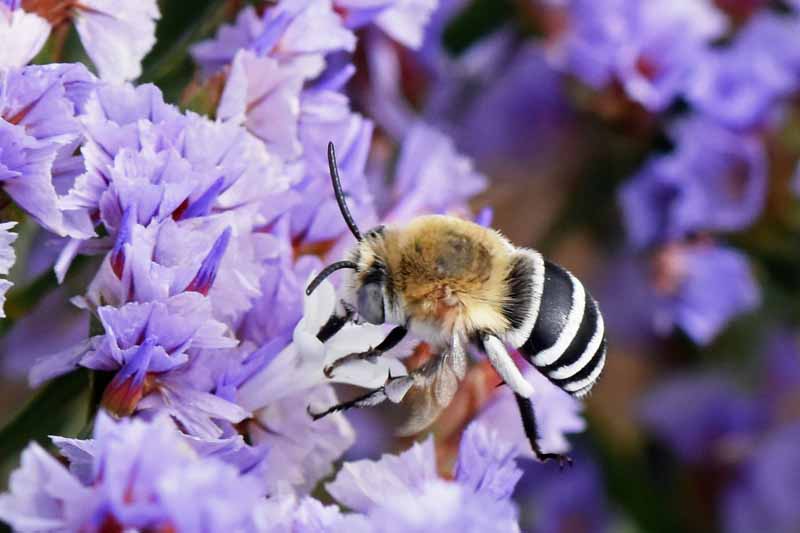
Small to medium in size, these species typically measure between 1/4 to 3/4 inch in length and include the common Colletes inaequalis as well as sweat bees from the Halictidae family, miners in the Andrena family, and diggers in the subfamily Apidae.
Like many other species, they have variations in appearance with brown or black wings, black bodies, and stripes of orange, tan, yellow, or white. And some may have hairless or hairy abdomens, metallic brass, green, or blue bodies, or iridescent wings.
Non-aggressive, only the females are able to sting, though they will rarely do so and only when handled roughly.
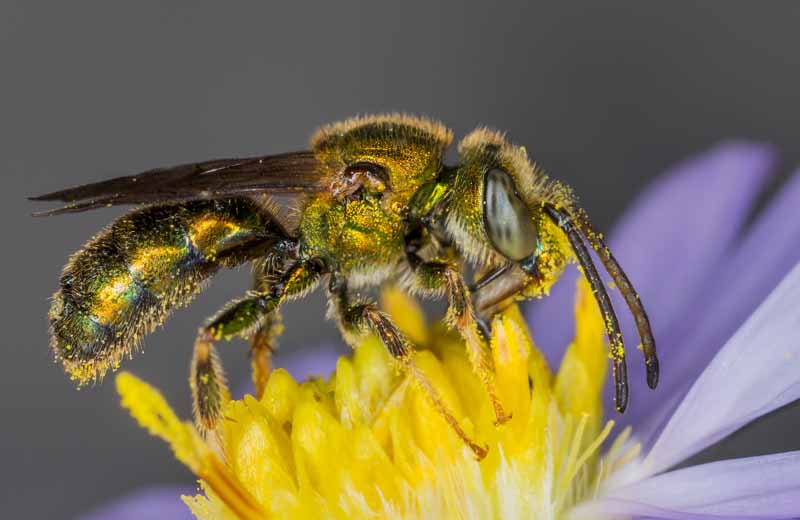
These species of ground-nesters are socially solitary and like to dig into dry soil – not wood – to create nest sites.
Each female finds a suitable south-facing site (often bare patches in the lawn or garden), then diligently burrows an entrance and a series of brood tunnels.
She mounds the freshly dug soil around her entrance and stockpiles the nursery with pollen and nectar for her offspring. C. inaequalis even lines her nest with a cellophane-like secretion, providing a waterproof barrier that also helps to keep eggs safe from fungal disease.
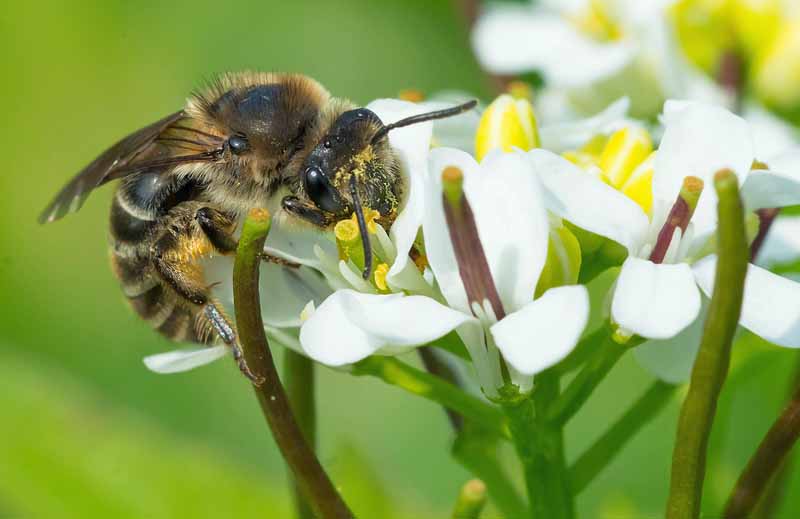
Although they’re solitary nesters, many will congregate and build nests close to family members. Nests are easily identified by their conical mounds of dirt, with a circular 1/4- to 1/2-inch entrance that only permits a solitary flier to enter or exit.
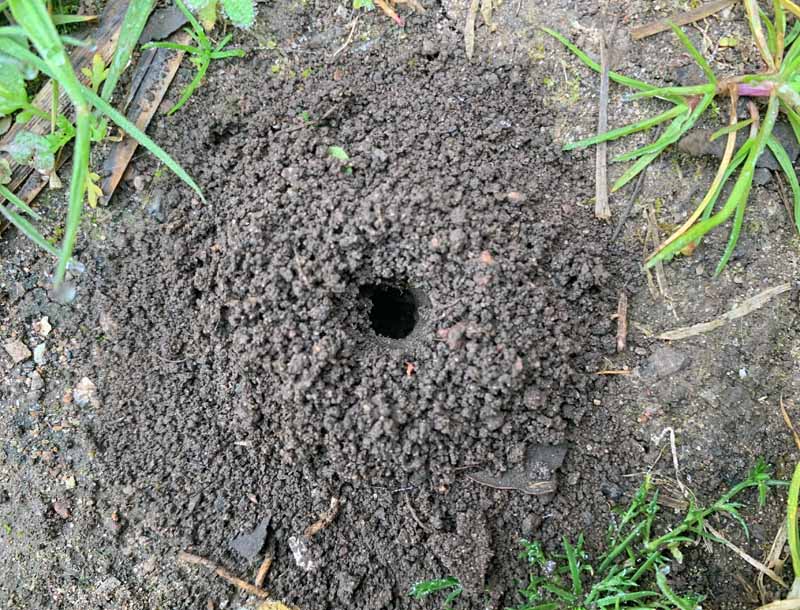
They mate, nest, and lay eggs for only six to eight weeks before dying, while the late-season eggs safely develop in underground nurseries to emerge the following spring.
Natural Predators
Backyard bees have several predators that help to keep populations in check:
Predatory birds include bee-eaters, spotted flycatchers, tits, shrikes, and woodpeckers.
Insects will also hunt them, such as the crab spider, Musomania vatia, plus dragonflies, robber flies, and wasps.
Mammals and rodents such as bears, field mice, foxes, minks, shrews, skunks, and weasels will all consume flying adults and nest contents.
What’s the Buzz?
Now that you can confidently identify some of your backyard bees, you’ll be able to tell potential pests apart from the purely beneficial ones.
Remember that carpenter bees have a bare abdomen whereas bumblebees are hairy, and ground nesters aren’t the same ones that burrow into wood. All are important pollinators.
Do you have any problems with or questions about backyard bees? Drop us a line in the comments below. And if you are having issues with wood nesting bees, check out our article on how to prevent them from attacking your home – it offers some easy tips to keep them at bay.
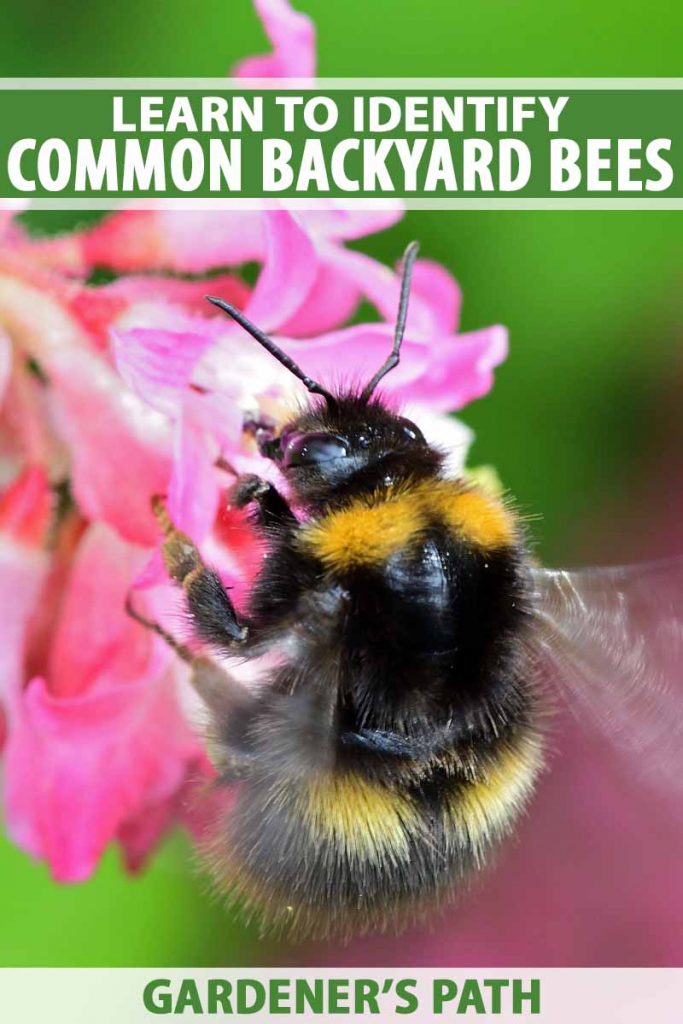
How can I move on a group of ground nesting bees under a shed slab that will need to come up shortly, without killing them?
Hi Peter, moving them is going to be tricky. Most ground nests will die out on their own in late autumn or winter and they don’t usually return to the same nesting site – although it does happen sometimes. If it can wait until then, fork the ground deeply in winter to break up the tunnels then cover the area. But, it sounds like you’ve got a construction project planned for the summer… You can try to move them by shoveling out large, deep sections of soil – but, some of the tunnels can be quite deep… Read more »
I have what looks to be ground bees in my front yard, but there isn’t the typical dry mound around their hole as pics show with ground bees. These look like honeybees, but just in the ground. They are def. not yellowjackets. Their hole is close (5 feet) from a hole inhabited by bumblebees. I want to help these pollinators, but also need to mow the lawn. Do you think I can safely mow around or over these bee nests? The grass is getting tall!
Hi Amy, sounds like they love your yard!
If there are no mounds for the blades to slice into, and they’re definitely not yellow jackets, you can mow over the nests.
However, the loud vibration of mowers can disturb them into thinking they’re under attack. And while many of the males are stingless, some females will sting when threatened.
I’d suggest hand trimming the immediate area (one-yard diameter) with pruning shears, and mowing the rest of the lawn to keep you, and the bees, safe.
Thanks for caring about our pollinators!
Our old barn has a plank wood floor. Just inside the east entrance, I’ve seen dark bees (some have a bit of yellow) coming & going from under a plank that is ajar. I’ve attempted to get a photo but they fly so quickly. So far, they’ve never been aggressive. This east entrance is our most used door. Could these be carpenter bees?
They could be Carole, although if they’re flying under the plank floor, I’m more inclined to think they’re ground burrowers.
Their size could be a clue – carpenters are quite big, and look similar to bumblebees while the ground nesters are usually small to medium sized.
Either species will be non-aggressive if allowed access to their nest without harassment. In the winter, you can have a closer look for a nest entrance to determine what species they are and evict any overwintering residents if needed.
Thanks for asking!
How or what do I do? Every summer now 4 years and counting my walkway looks like this with very active workers.
Hey Candi, I think water is going to be your best tactic to get the miners to move and prevent them from returning. The species that build ground nests like dry soil and turning on an oscillating sprinkler to water the area for a couple of hours each day should get them to move out to find drier premises. Over winter, fill in the holes with sand and tamp it down between the pavers. In early spring, turn the sprinkler back on to discourage them from returning to established nesting sites. Hope that helps, and let us know how it… Read more »
I saw this bee entering the soil in one of my planter boxes here in upstate NY. It was carrying a small praying mantis. It has the body of a wasp, but about an inch and a quarter in length. Any idea what it might be?
Hey Frank, from the distinctive yellow head marking and leg coloration, plus its food choice, I’d guess it’s a great golden digger wasp, Sphex incheumoneus.
They’re native throughout North and Central America, nest in the soil, and feed their young on crickets, grasshoppers, and other similar insects – like preying mantis.
They’re not considered an aggressive species and generally mind their own business if left undisturbed. She’s made her tunnel, stocked it with the mantis for the egg to feed on as it matures, and should now be off making new tunnels elsewhere.
Thanks for asking!
Thank you Lorna
Hi,
I have bees flying in and out of old railroad tie steps. They are small, but sting my little dog who now is afraid to go outside in the backyard. Today she came running around the side yard acting like she was attacked again. I have to use those steps also. What do you think I should do? They have been there all summer. I live in middle Minnesota.
Hey Julie, sorry to hear about your pup!
For a natural solution, you could try turning some water on your wooden steps to encourage them to move to another location – they need dry nesting sites. A small sprinkler set to low pressure and left on for a couple of hours daily might do the trick.
Then, in the winter after they die off, locate the nest site(s), destroy any overwintering eggs, and seal the entrance holes. If possible, paint or waterproof the ties to discourage burrowing insects from building new nests.
Hope that helps!
I have mounds in my yard with large openings. I saw a black bee with a smooth abdomen crawl inside. I also see a single black bee hovering. What kind of bees do I have and what can I do to get rid of them? Do not know when this started, but it is August now, not spring, and new hills pop up every day.
????
Hey Kathy, it’s hard to tell without seeing the them… any chance you can take a photo and send it in?
Because these insects require dry nesting sites, the best way to get them to move on is with water.
Turn on a sprinkler for a few hours a day to encourage them to seek a drier location. Repeat watering in the same area next summer will help them to look elsewhere to build nests.
Hope that helps!
I have a mound of dirt that after clearing buckthorn seems to have risen quite taller than before. It’s about 4 ft by 2 ft and I heard a faint sound like water but could be wings inside the nest. I didn’t see anything going in and out. This was discovered this evening so I backed away for now. Any idea? Also its location is in the back corner of the backyard.
Hey Jason, it’s hard to say without a photo, but from the size of the nest I’d guess that they’re social ground wasps or yellow jackets. These insects build large colonies and stings can be painful. For the most part, they’re non-aggressive if left undisturbed. But, they can be nasty in high traffic areas. If it’s out of the way in the back corner, you can leave it until winter. The workers will die off and only ones that will overwinter are the queens, and they don’t re-nest in the same area the following year. Hope that helps, and if… Read more »
GM, Is this the work of a ground bee…? It is parallel to my driveway and I do cut the grass here/ what should I do? I have no issues w/ the bee/bees just don’t want to harm them.
It certainly looks like the nest of one of the solitary types, Rachel.
They’re quite docile, but if you can avoid mowing over the nest, it would be best. The strong vibrations can make them think they’re under attack, and they could respond in kind.
But, if you’re up for it, you can hand trim around it with scissors or garden snips until the growing season ends. They die off in winter and typically don’t relocate in the the same nest the following year.
Thanks for asking!
Good evening! Hope this finds you well. Today, we found a small hole in one of our flower beds with what we think might be bumblebees flying in and out all day. We were not able to get the best of pics, but I have included a couple. We have a small dog and a semi-feral cat that “adopted” us (she lives on our screened porch). We are most concerned for their safety, and wondered if we should try to encourage the bees move along.
Thank you for your time!
Hi Susan, that does look like a nest of bumblers. They’re usually quite non-aggressive if left undisturbed, but a curious dog or cat could definitely put them on the defense. Bombus species can build large colonies, but by winter all the workers die off and the new queens have mated and moved on. At this time the population is starting to die back, but I would still be concerned about trying to move them. Water might work, but if it’s a large colony, they could persist. They won’t be around for much longer, so I would try to rig up… Read more »
Thank you so very much for the response! We will create a barrier to separate our 4-legged from our 6-legged critters. Stay healthy and safe! Susan
Hi…I have a pile of cut weeds, some wood chips, old plants and cuttings, some dirt perhaps….neglected for a number of months…..there is an entrance, without visible dust of sand moved by the bees, but bees are going in and out all day like helicopters in lower Manhattan ….I had one sting till I notices the activity, and stayed away without cleaning the pile….I cannot get close enough to ID the insects….look more like bees than wasps or hornets…..Shall I wait till deep frost then try to open the debris, and hope for winter kill. I hate to use chemicals….Thoughts?
Yes, that’s what I would do Dan. If it’s easy for you to stay out of their way, let nature takes it course because the workers will all die off shortly. You can then clean up the debris in winter. I’d also dig into the soil below the pile with a garden fork – aerating it a bit so the frost can penetrate deeper to kill any overwintering eggs. Or, because they usually don’t re-nest in the same site, you could wait until early next spring when the new queens emerge and leave to build new nests. After they leave,… Read more »